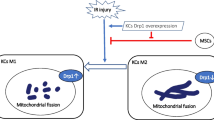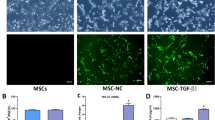Abstract
Sepsis is a leading cause of death in intensive care units that can result in acute hepatic damage. Animal experiments and clinical trials have shown that mesenchymal stem cell (MSC) therapy has some beneficial in several liver diseases. However, the protective effects of MSC therapy on sepsis-induced hepatic damage and associated mechanisms are not completely understood. The aim of the present study was to investigate the effects of MSCs on sepsis-induced liver injury and underlying mechanisms. A rat model of sepsis-induced liver injury was established by cecal ligation and puncture, and serum alanine aminotransferase and aspartate transaminase activities as well as liver histological changes were measured. Inflammatory cytokines, Kupffer cell M1 phenotype markers, and associated signal molecules were also determined in septic rats and in lipopolysaccharide (LPS)-treated Kupffer cells. Our results showed that injection of MSCs attenuated sepsis-induced liver injury. Treatment with MSCs inhibited activation of Kupffer cells towards M1 phenotype, attenuated TNF-α and IL-6 expression, and promoted IL-4 and IL-10 expression in septic rats and LPS-treated Kupffer cells. Furthermore, MSCs also inhibited the nuclear translocation of nuclear factor-kappa B in LPS-challenged Kupffer cells and the liver of septic rats. These results indicated that MSCs attenuated sepsis-induced liver injury through suppressing M1 polarization of Kupffer cells.




Similar content being viewed by others
References
Nolan JP (2010) The role of intestinal endotoxin in liver injury: a long and evolving history. Hepatology 52(5):1829–1835
Kudo H, Takahara T, Yata Y, Kawai K, Zhang W, Sugiyama T (2009) Lipopolysaccharide triggered TNF-alpha-induced hepatocyte apoptosis in a murine non-alcoholic steatohepatitis model. J Hepatol 51(1):168–175
Kaffarnik MF, Lock JF, Vetter H, Ahmadi N, Lojewski C, Malinowski M, Neuhaus P, Stockmann M (2013) Early diagnosis of sepsis-related hepatic dysfunction and its prognostic impact on survival: a prospective study with the LiMAx test. Crit Care 17(5):R259
Kobashi H, Toshimori J, Yamamoto K (2013) Sepsis-associated liver injury: Incidence, classification and the clinical significance. Hepatol Res 43(3):255–266
Hoofnagle JH, Carithers RL Jr, Shapiro C, Ascher N (1995) Fulminant hepatic failure: summary of a workshop. Hepatology 21(1):240–252
Seki S, Habu Y, Kawamura T, Takeda K, Dobashi H, Ohkawa T, Hiraide H (2000) The liver as a crucial organ in the first line of host defense: the roles of Kupffer cells, natural killer (NK) cells and NK1.1 Ag + T cells in T helper 1 immune responses. Immunol Rev 174:35–46
Thomson AW, Knolle PA (2010) Antigen-presenting cell function in the tolerogenic liver environment. Nat Rev Immunol 10(11):753–766
Ashare A, Monick MM, Powers LS, Yarovinsky T, Hunninghake GW (2006) Severe bacteremia results in a loss of hepatic bacterial clearance. Am J Respir Crit Care Med 173(6):644–652
Drommelschmidt K, Serdar M, Bendix I, Herz J, Bertling F, Prager S, Keller M, Ludwig AK, Duhan V, Radtke S, de Miroschedji K, Horn PA, van de Looij Y, Giebel B, Felderhoff-Muser U (2017) Mesenchymal stem cell-derived extracellular vesicles ameliorate inflammation-induced preterm brain injury. Brain Behav Immun 60:220–232
Sargent A, Miller RH (2016) MSC Therapeutics in Chronic Inflammation. Curr Stem Cell Rep 2(2):168–173
Lai TS, Wang ZH, Cai SX (2015) Mesenchymal stem cell attenuates neutrophil-predominant inflammation and acute lung injury in an in vivo rat model of ventilator-induced lung injury. Chin Med J (Engl) 128(3):361–367
Amin MA, Sabry D, Rashed LA, Aref WM, el-Ghobary MA, Farhan MS, Fouad HA, Youssef YA (2013) Short-term evaluation of autologous transplantation of bone marrow-derived mesenchymal stem cells in patients with cirrhosis: Egyptian study. Clin Transplant 27(4):607–612
Suk KT, Yoon JH, Kim MY, Kim CW, Kim JK, Park H, Hwang SG, Kim DJ, Lee BS, Lee SH, Kim HS, Jang JY, Lee CH, Kim BS, Jang YO, Cho MY, Jung ES, Kim YM, Bae SH, Baik SK (2016) Transplantation with autologous bone marrow-derived mesenchymal stem cells for alcoholic cirrhosis: Phase 2 trial. Hepatology 64(6):2185–2197
Wang L, Li J, Liu H, Li Y, Fu J, Sun Y, Xu R, Lin H, Wang S, Lv S, Chen L, Zou Z, Li B, Shi M, Zhang Z, Wang FS (2013) Pilot study of umbilical cord-derived mesenchymal stem cell transfusion in patients with primary biliary cirrhosis. J Gastroenterol Hepatol 28(Suppl 1):85–92
Lin BL, Chen JF, Qiu WH, Wang KW, Xie DY, Chen XY, Liu QL, Peng L, Li JG, Mei YY, Weng WZ, Peng YW, Cao HJ, Xie JQ, Xie SB, Xiang AP, Gao ZL (2017) Allogeneic bone marrow-derived mesenchymal stromal cells for hepatitis B virus-related acute-on-chronic liver failure: a randomized controlled trial. Hepatology 66(1):209–219
Liang XJ, Chen XJ, Yang DH, Huang SM, Sun GD, Chen YP (2012) Differentiation of human umbilical cord mesenchymal stem cells into hepatocyte-like cells by hTERT gene transfection in vitro. Cell Biol Int 36(2):215–221
Rittirsch D, Huber-Lang MS, Flierl MA,Ward PA (2009) Immunodesign of experimental sepsis by cecal ligation and puncture. Nat Protoc 4(1):31–36
Cusack CL, Swahari V, Hampton Henley W, Michael Ramsey J, Deshmukh M (2013) Distinct pathways mediate axon degeneration during apoptosis and axon-specific pruning. Nat Commun 4:1876
Németh K, Leelahavanichkul A, Yuen PS, Mayer B, Parmelee A, Doi K, Robey PG, Leelahavanichkul K, Koller BH, Brown JM, Hu X, Jelinek I, Star RA, Mezey E (2009) Bone marrow stromal cells attenuate sepsis via prostaglandin E(2)-dependent reprogramming of host macrophages to increase their interleukin-10 production. Nat Med 15(1):42–49
Horák J, Nalos L, Martínková V, Beneš J, Štengl M, Matějovič M (2017) Mesenchymal stem cells in sepsis and associated organ dysfunction: a promising future or blind alley? Stem Cells Int 2017:7304121. https://doi.org/10.1155/2017/7304121
Mareschi K, Ferrero I, Rustichelli D, Aschero S, Gammaitoni L, Aglietta M, Madon E, Fagioli F (2006) Expansion of mesenchymal stem cells isolated from pediatric and adult donor bone marrow. J Cell Biochem 97(4):744–754
Watson N, Divers R, Kedar R, Mehindru A, Mehindru A, Borlongan MC, Borlongan CV (2015) Discarded Wharton jelly of the human umbilical cord: a viable source for mesenchymal stromal cells. Cytotherapy 17(1):18–24
Wang HS, Hung SC, Peng ST, Huang CC, Wei HM, Guo YJ, Fu YS, Lai MC, Chen CC (2004) Mesenchymal stem cells in the Wharton’s jelly of the human umbilical cord. Stem Cells 22(7):1330–1337
Shin S, Kim Y, Jeong S, Hong S, Kim I, Lee W, Choi S (2013) The therapeutic effect of human adult stem cells derived from adipose tissue in endotoxemic rat model. Int J Med Sci 10(1):8–18
Chao YH, Wu HP, Wu KH, Tsai YG, Peng CT, Lin KC, Chao WR, Lee MS, Fu YC (2014) An increase in CD3 + CD4 + CD25 + regulatory T cells after administration of umbilical cord-derived mesenchymal stem cells during sepsis. PLoS ONE 9(10):e110338. https://doi.org/10.1371/journal.pone.0110338
Liu S, Yuan M, Hou K, Zhang L, Zheng X, Zhao B, Sui X, Xu W, Lu S, Guo Q (2012) Immune characterization of mesenchymal stem cells in human umbilical cord Wharton’s jelly and derived cartilage cells. Cell Immunol 278(1–2):35–44
Tacke F, Zimmermann HW (2014) Macrophage heterogeneity in liver injury and fibrosis. J Hepatol 60(5):1090–1096
Wan J, Benkdane M, Teixeira-Clerc F, Bonnafous S, Louvet A, Lafdil F, Pecker F, Tran A, Gual P, Mallat A, Lotersztajn S, Pavoine C (2014) M2 Kupffer cells promote M1 Kupffer cell apoptosis: a protective mechanism against alcoholic and nonalcoholic fatty liver disease. Hepatology 59(1):130–142
Maggini J, Mirkin G, Bognanni I, Holmberg J, Piazzón IM, Nepomnaschy I, Costa H, Cañones C, Raiden S, Vermeulen M, Geffner JR (2010) Mouse bone marrow-derived mesenchymal stromal cells turn activated macrophages into a regulatory-like profile. PLoS ONE 5(2):e9252. https://doi.org/10.1371/journal.pone.0009252
Kang JW, Lee SM (2016) Resolvin D1 protects the liver from ischemia/reperfusion injury by enhancing M2 macrophage polarization and efferocytosis. Biochim Biophys Acta 1861(9Pt A):1025–1035. https://doi.org/10.1016/j.bbalip.2016.06.002
Xie J, Wu X, Zhou Q, Yang Y, Tian Y, Huang C, Meng X, Li J (2016) PICK1 confers anti-inflammatory effects in acute liver injury via suppressing M1 macrophage polarization. Biochimie 127:121–132
Courtine E, Pene F, Cagnard N, Toubiana J, Fitting C, Brocheton J, Rousseau C, Gerondakis S, Chiche JD, Ouaaz F, Mira JP (2011) Critical role of cRel subunit of NF-kB in sepsis survival. Infect Immun 79(5):1848–1854
Jin LY, Li CF, Zhu GF, Wu CT, Wang J, Yan SF (2014) Effect of siRNA against NF-kB on sepsis-induced acute lung injury in a mouse model. Mol Med Rep 10(2):631–637
Li H, Han W, Polosukhin V, Yull FE, Segal BH, Xie CM, Blackwell TS (2013) NF-kB inhibition after cecal ligation and puncture reduces sepsis-associated lung injury without altering bacterial host defense. Mediators Inflamm 2013:503213. https://doi.org/10.1155/2013/503213
Ha T, Xia Y, Liu X, Lu C, Liu L, Kelley J, Kalbfleisch J, Kao RL, Williams DL, Li C (2011) Glucan phosphate attenuates myocardial HMGB1 translocation in severe sepsis through inhibiting NF-kB activation. Am J Physiol Heart Circ Physiol 301(3):H848–H855
Fang JP, Liu Y, Li J, Liao WF, Hu YH, Ding K (2012) A novel small molecule, HK-156, inhibits lipopolysaccharide-induced activation of NF-kB signaling and improves survival in mouse models of sepsis. Acta Pharmacol Sin 33(9):1204–1216
Sica A, Mantovani A (2012) Macrophage plasticity and polarization: in vivo veritas. J Clin Invest 122(3):787–795
Bonizzi G, Karin M (2004) The two NF-kappaB activation pathways and their role in innate and adaptive immunity. Trends Immunol 25(6):280–288
Acknowledgements
This study was supported by Science and Technology Planning Project of Guangdong Province, China (Grant number 32415102) and Jinan University’s Scientific Research Cultivation and Innovation Fund (Grant number 11615481).
Author information
Authors and Affiliations
Corresponding authors
Ethics declarations
Conflict of interest
The authors declare that they have no conflict of interest.
Ethical approval
All procedures performed in studies involving human participants were in accordance with the ethical standards of the institutional and/or national research committee and with the 1964 Helsinki declaration and its later amendments or comparable ethical standards.
Research involving human and/or animal rights
All applicable international, national, and/or institutional guidelines for the care and use of animals were followed. All procedures performed in studies involving animals were in accordance with the guide for the care and use of laboratory animals at Jinan University School of Medicine.
Electronic supplementary material
Below is the link to the electronic supplementary material.
Rights and permissions
About this article
Cite this article
Liang, X., Li, T., Zhou, Q. et al. Mesenchymal stem cells attenuate sepsis-induced liver injury via inhibiting M1 polarization of Kupffer cells. Mol Cell Biochem 452, 187–197 (2019). https://doi.org/10.1007/s11010-018-3424-7
Received:
Accepted:
Published:
Issue Date:
DOI: https://doi.org/10.1007/s11010-018-3424-7




